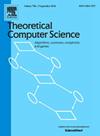On Conflict-Free Spanning Tree: Mapping tractable and hard instances through the lenses of graph classes
IF 0.9
4区 计算机科学
Q3 COMPUTER SCIENCE, THEORY & METHODS
引用次数: 0
Abstract
A natural constraint in real-world applications is avoiding conflicting elements in problem solutions. Let be a graph where each edge has a positive integer weight , and let be a conflict graph such that and each edge represents a conflict between two edges . In the Minimum Conflict-Free Spanning Tree (MCFST) problem, we are asked to find a spanning tree avoiding pairs of conflicting edges (if such a tree exists) with minimum cost. In contrast to the polynomial-time solvability of Minimum Spanning Tree, to determine whether an instance of MCFST admits a feasible solution is an -complete problem. In this paper, we present a multivariate complexity analysis of MCFST by considering particular classes of graphs G and . We show that the problem of determining whether an instance of MCFST has a feasible solution is -complete even if G is a bipartite planar subcubic graph, and is a disjoint union of paths with three vertices. Contrastingly, we show that when G is complete and is bipartite, then a solution for can be found in linear time, while the problem of finding an optimal solution is -hard. Also, we present (in)approximability results for MCFST on complete graphs G, and a parameterized algorithm regarding the distance from the conflict graph to a hereditary graph class for which MCFST on is polynomial-time solvable.
求助全文
约1分钟内获得全文
求助全文
来源期刊

Theoretical Computer Science
工程技术-计算机:理论方法
CiteScore
2.60
自引率
18.20%
发文量
471
审稿时长
12.6 months
期刊介绍:
Theoretical Computer Science is mathematical and abstract in spirit, but it derives its motivation from practical and everyday computation. Its aim is to understand the nature of computation and, as a consequence of this understanding, provide more efficient methodologies. All papers introducing or studying mathematical, logic and formal concepts and methods are welcome, provided that their motivation is clearly drawn from the field of computing.
 求助内容:
求助内容: 应助结果提醒方式:
应助结果提醒方式:


